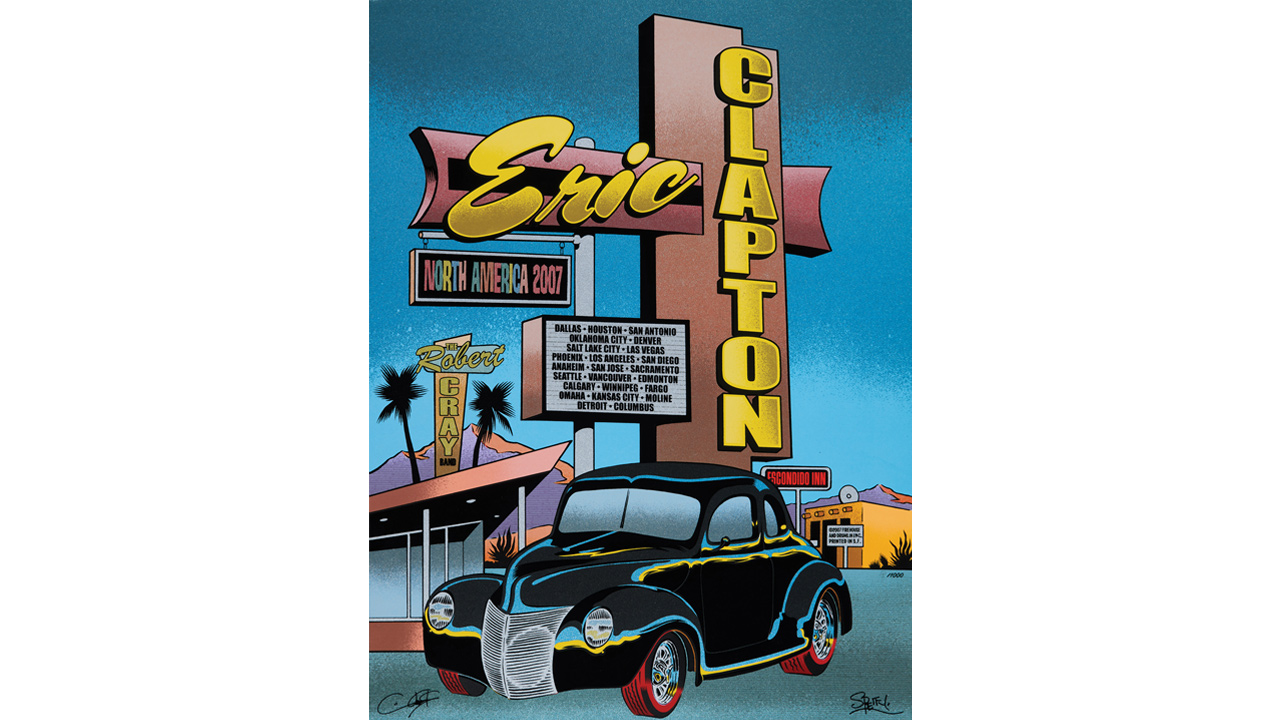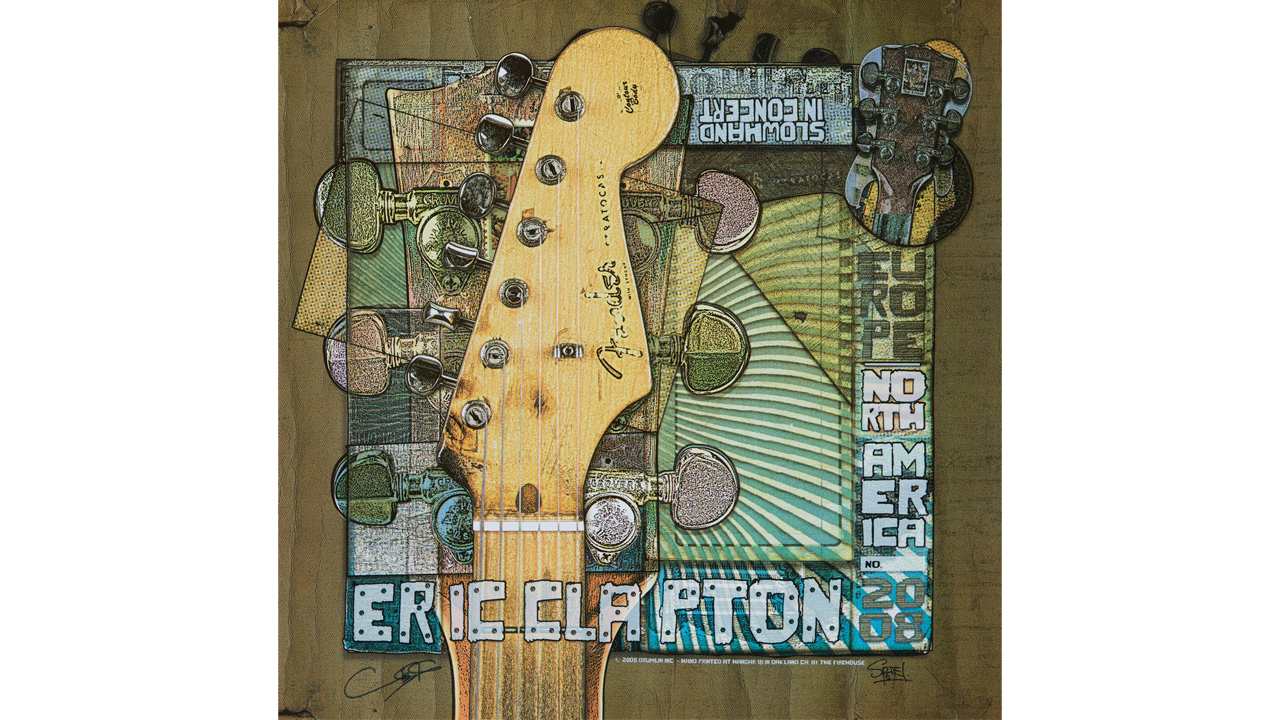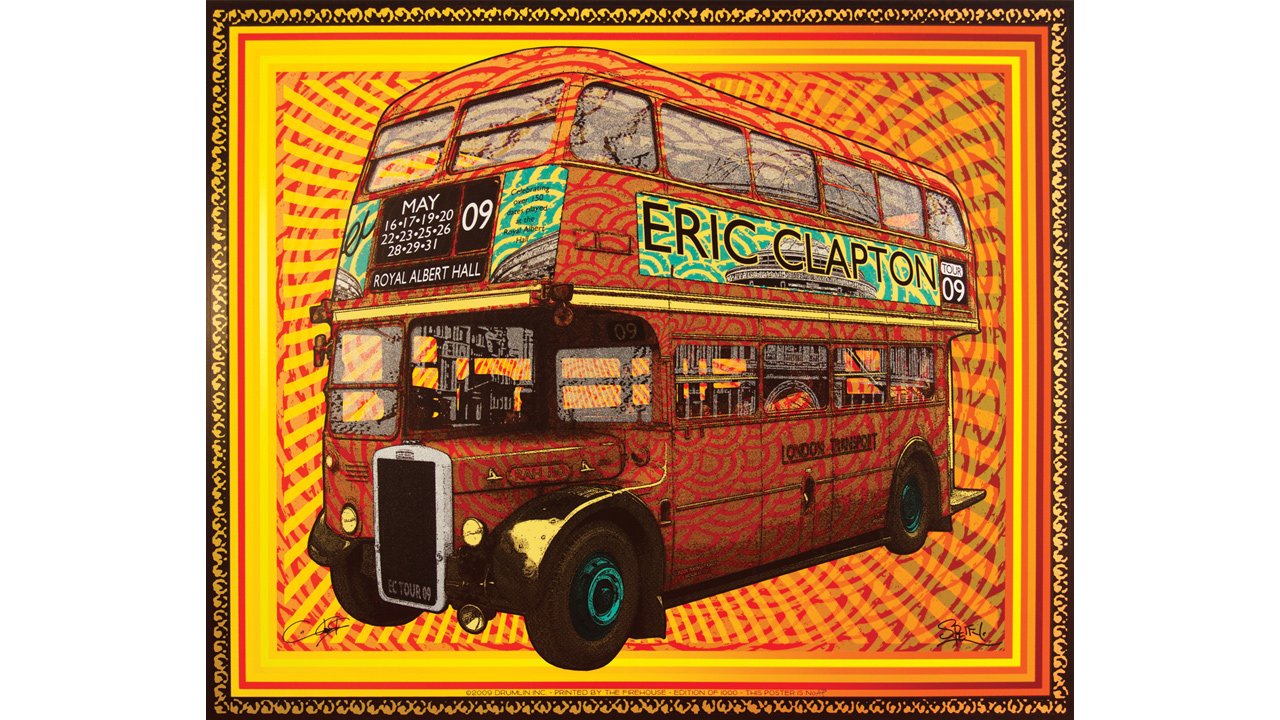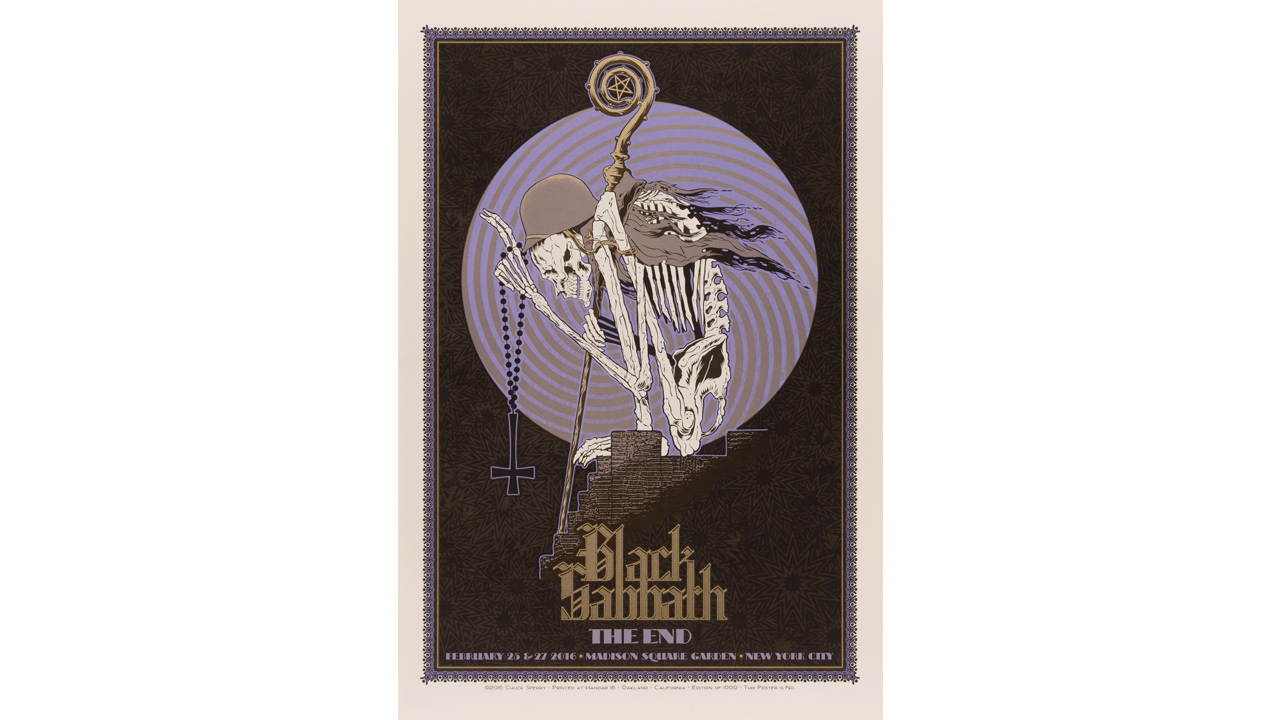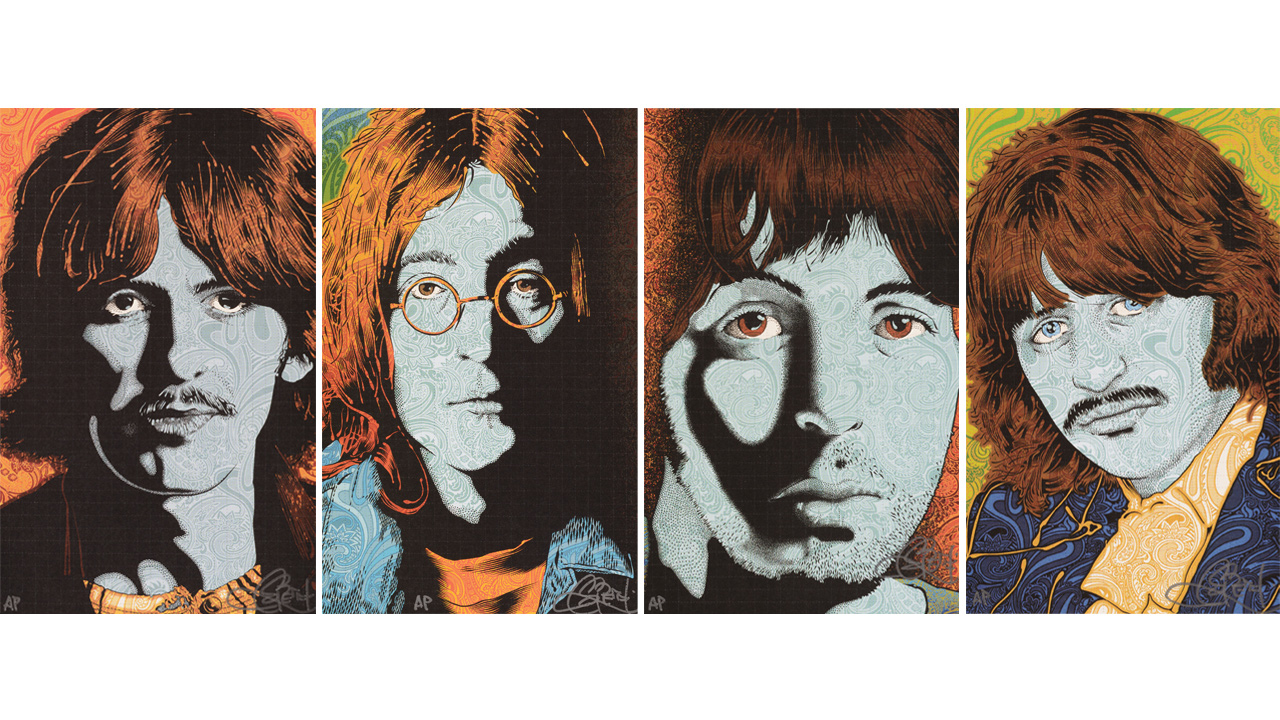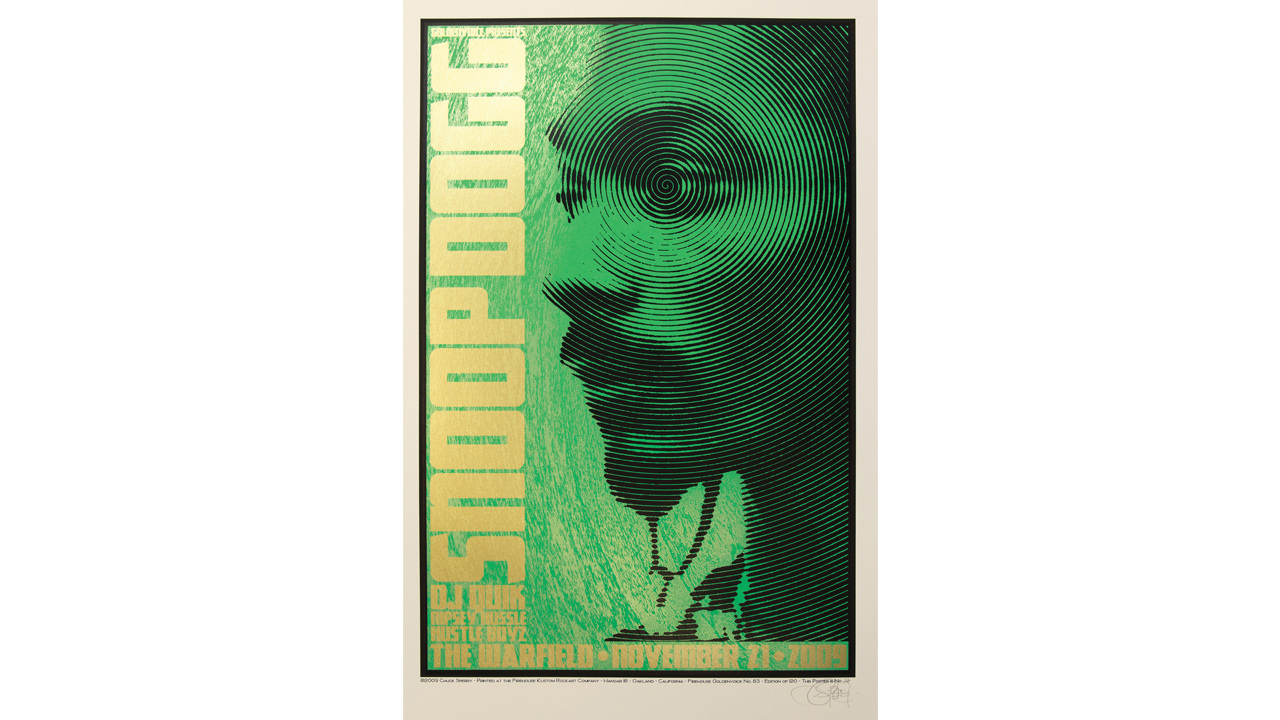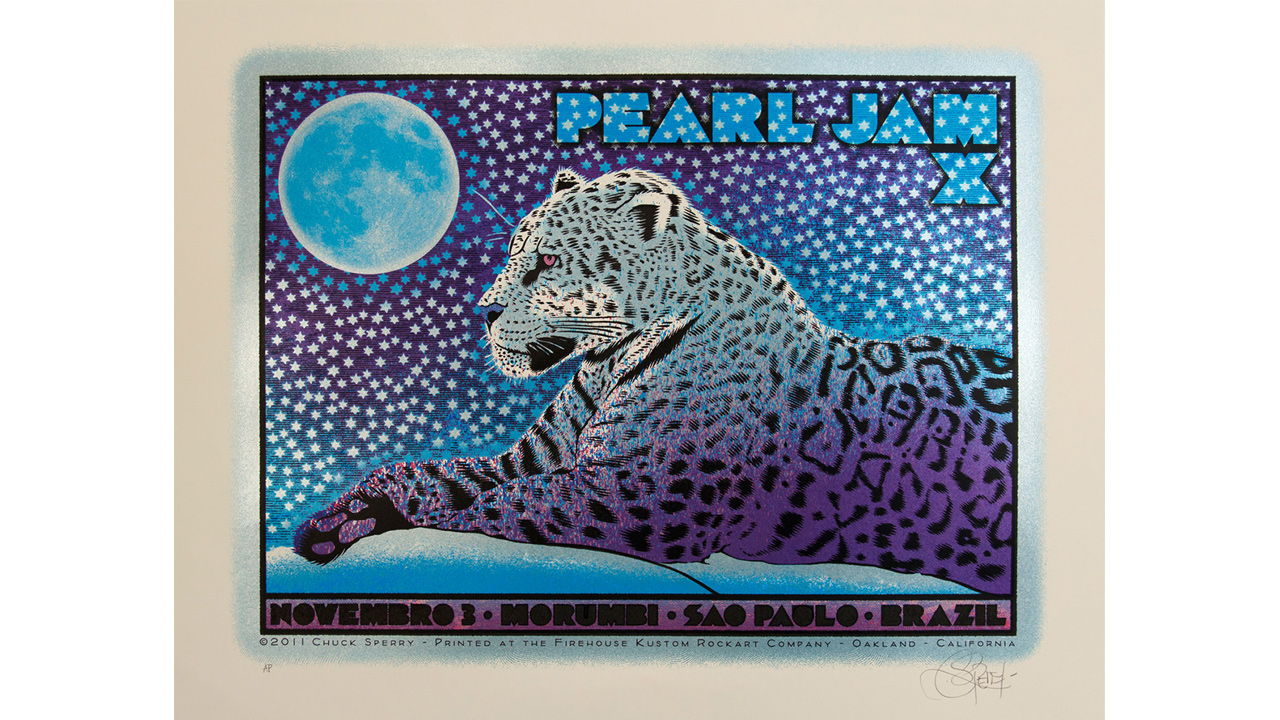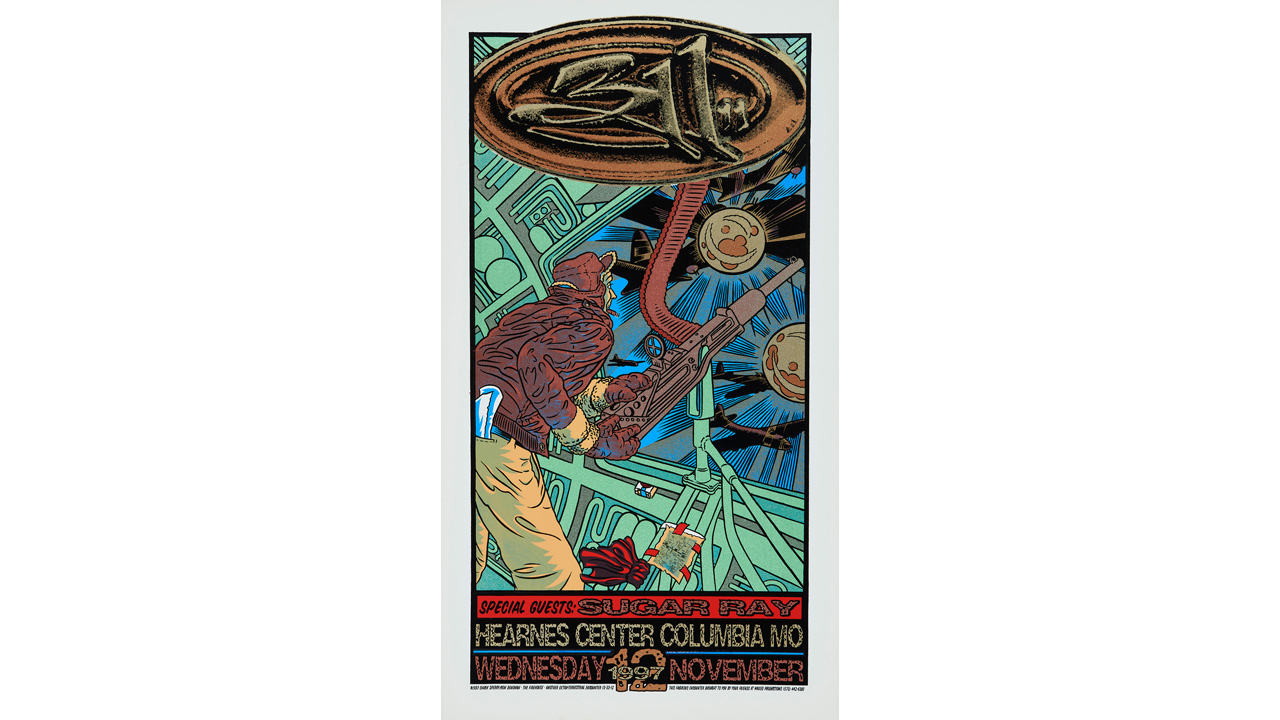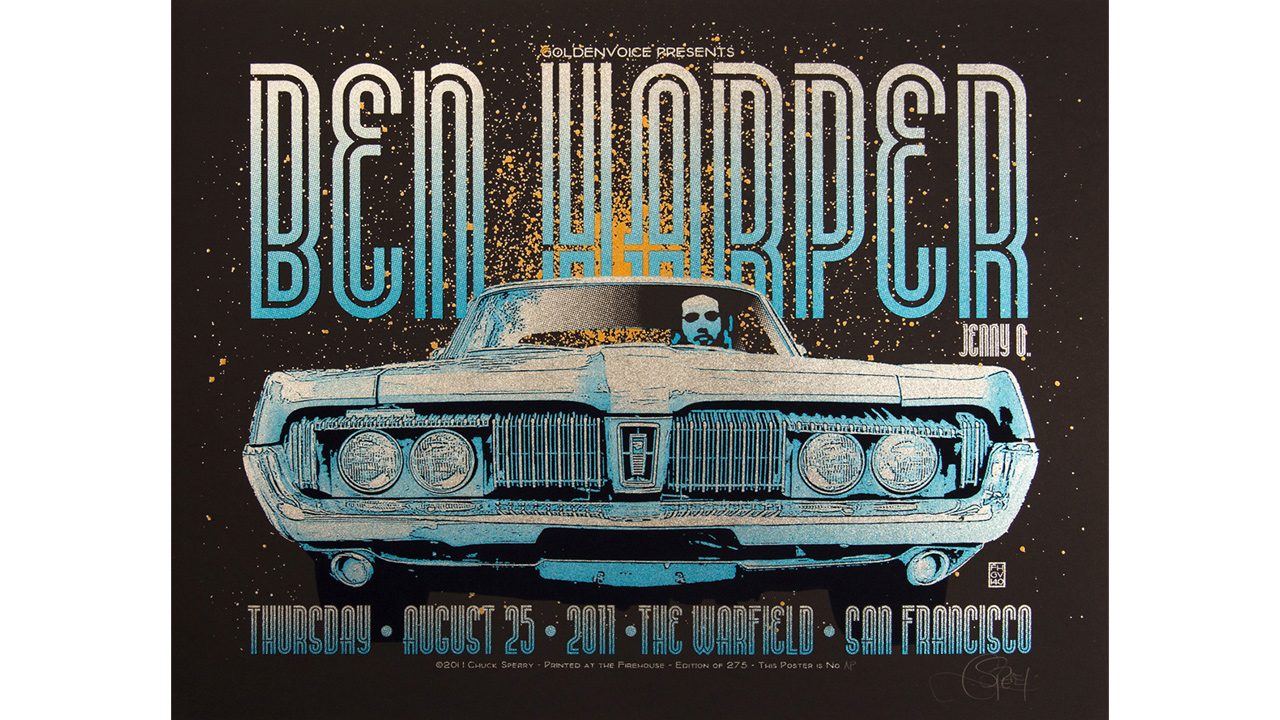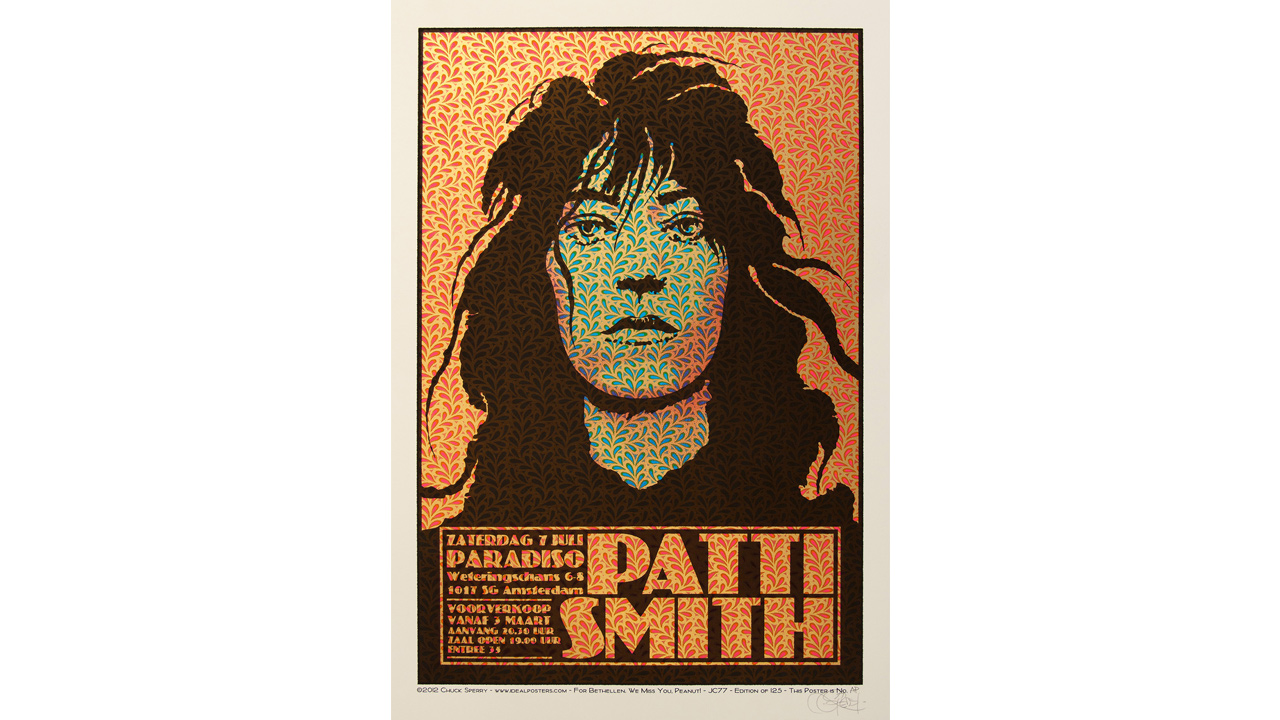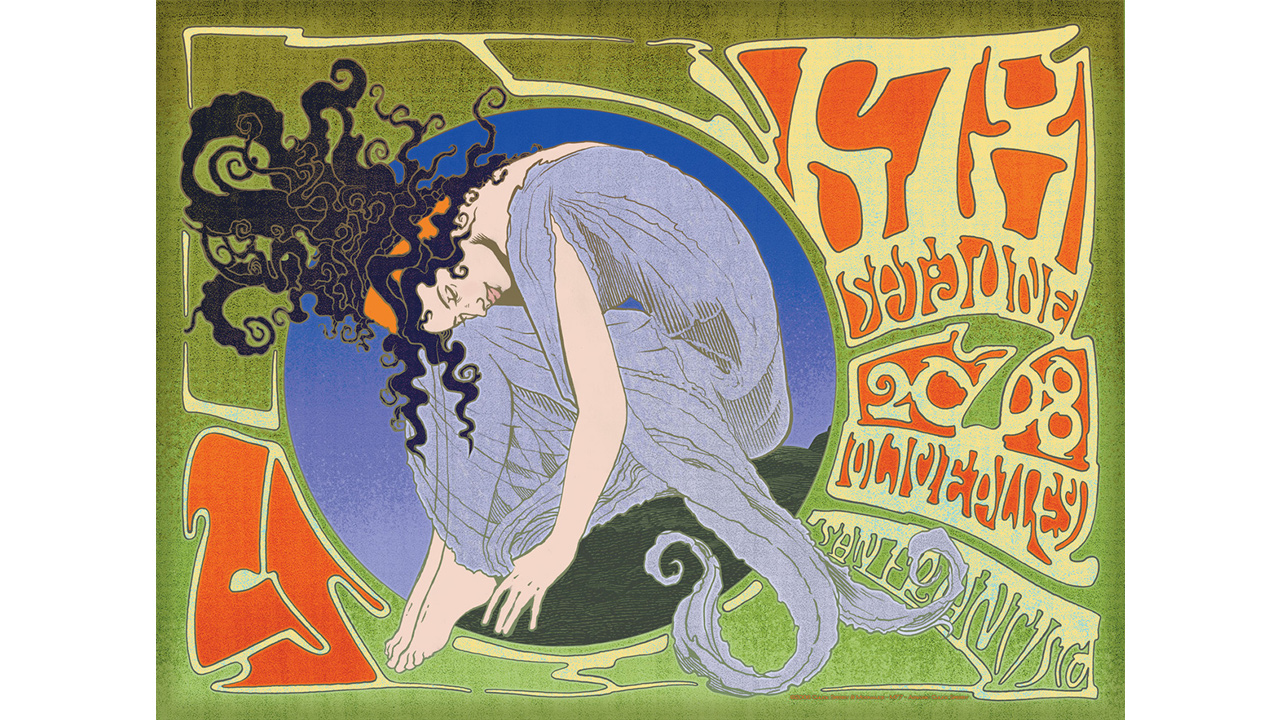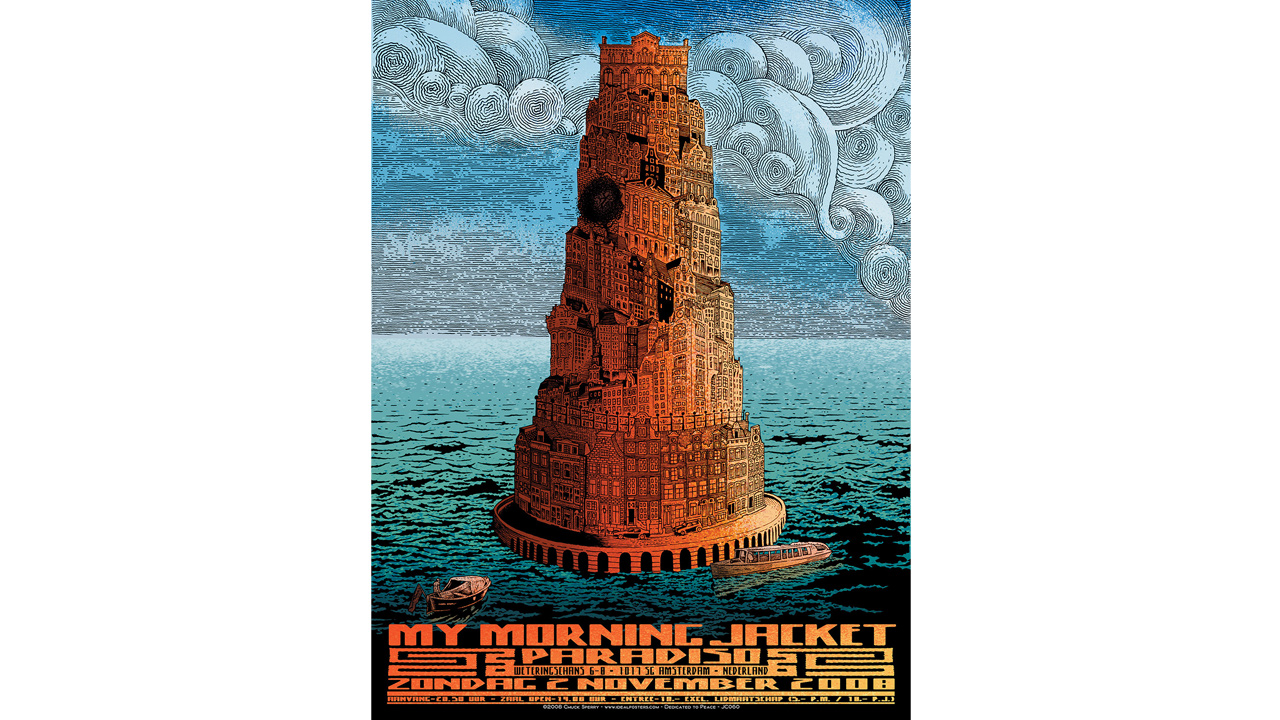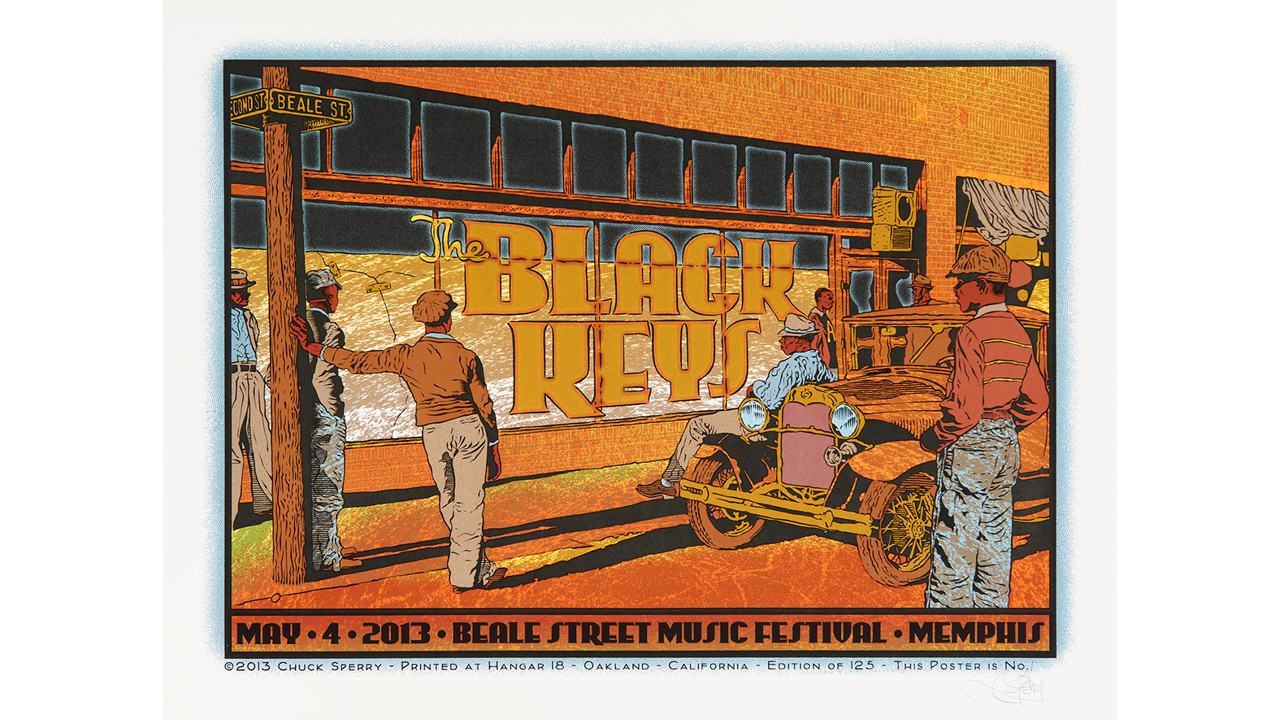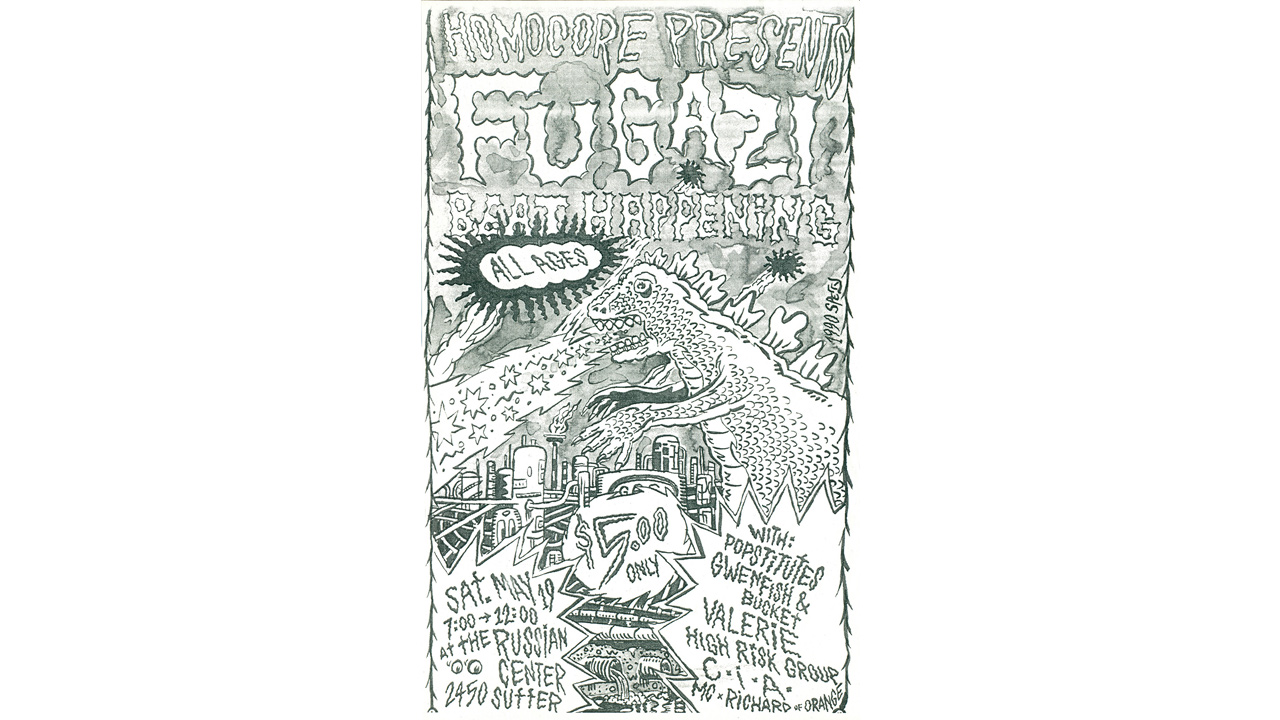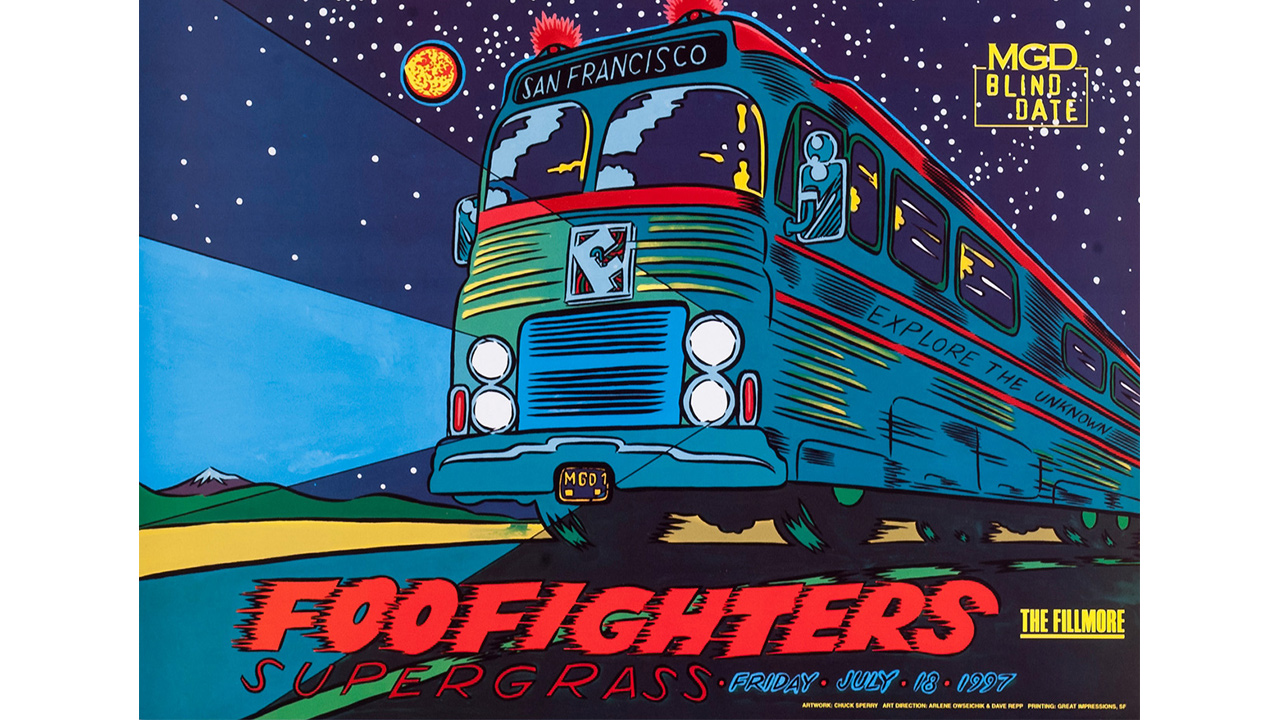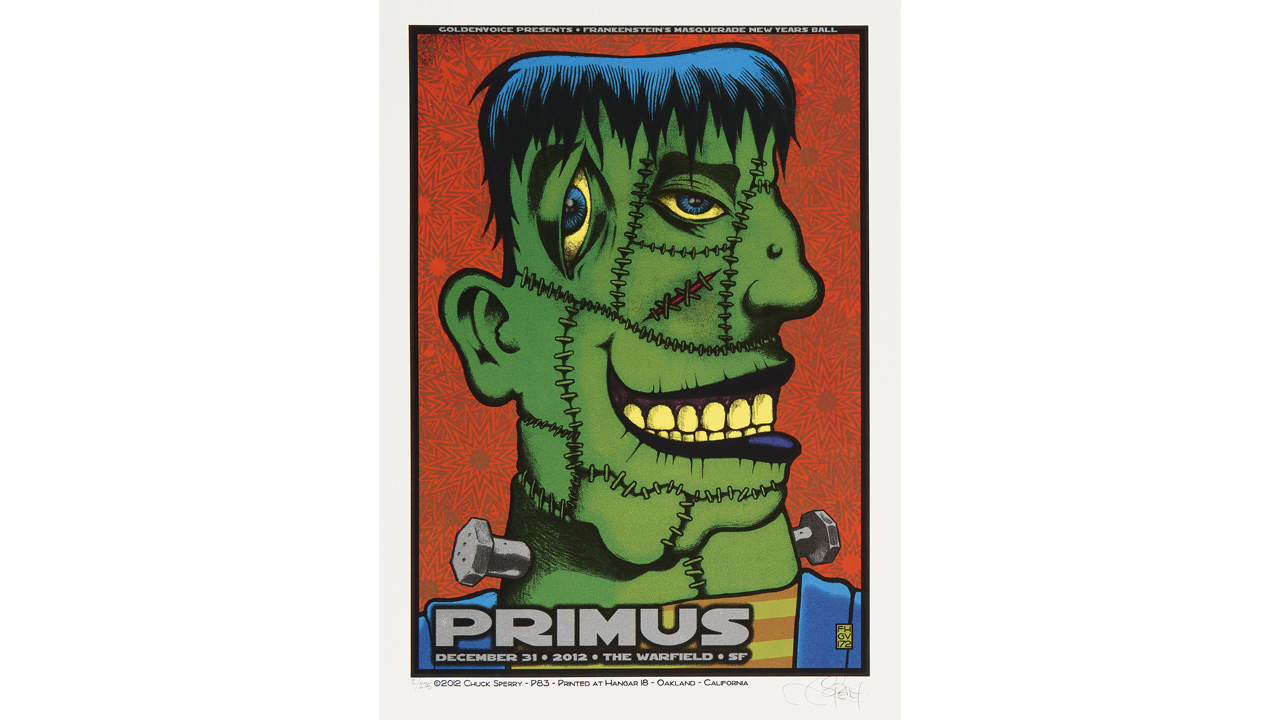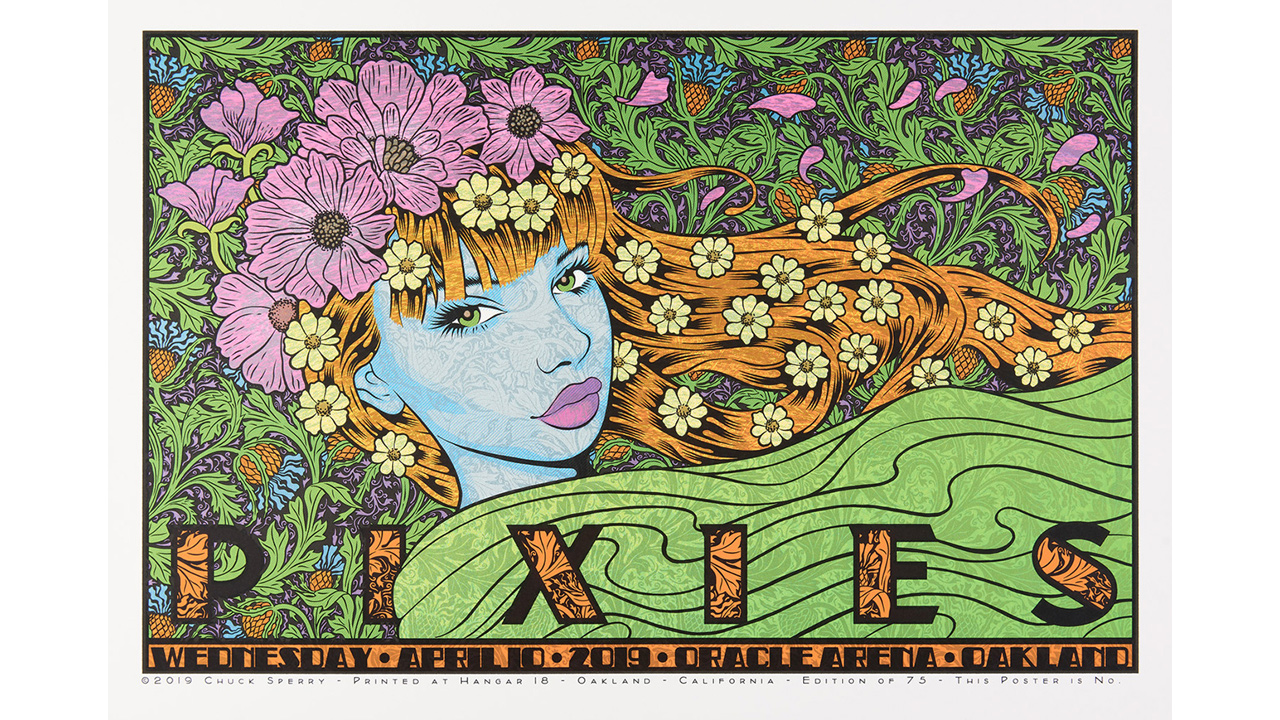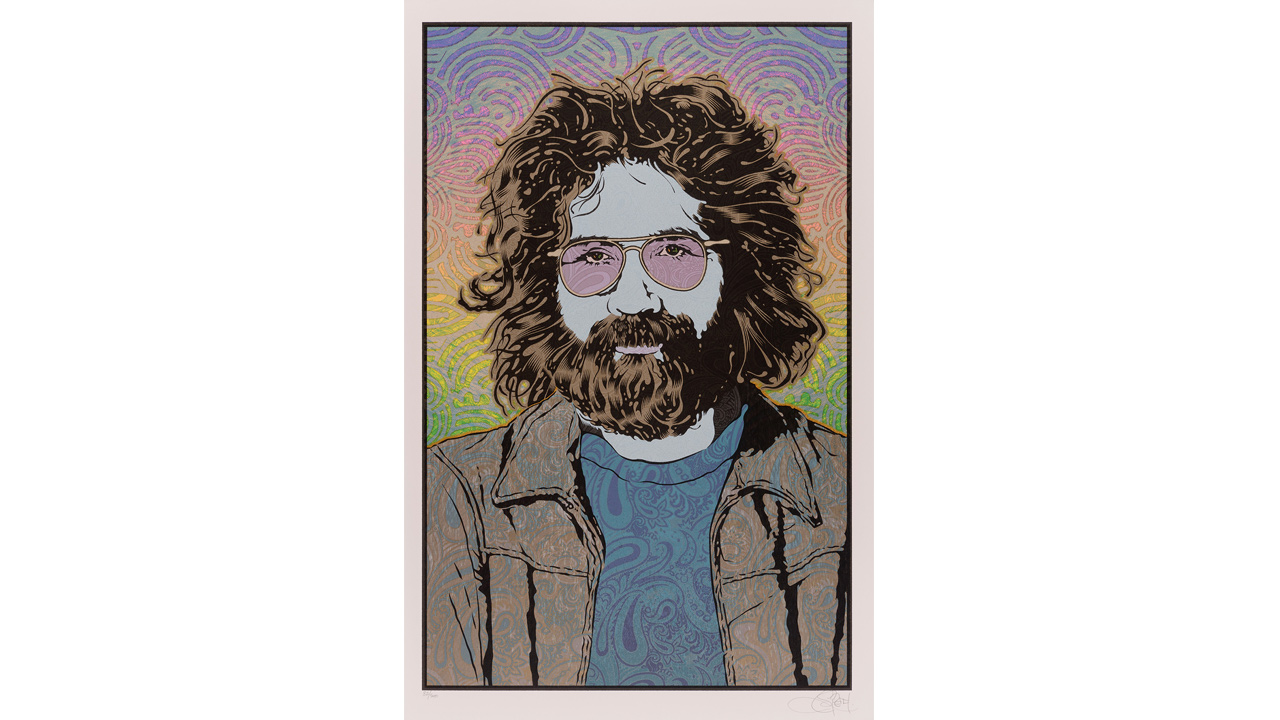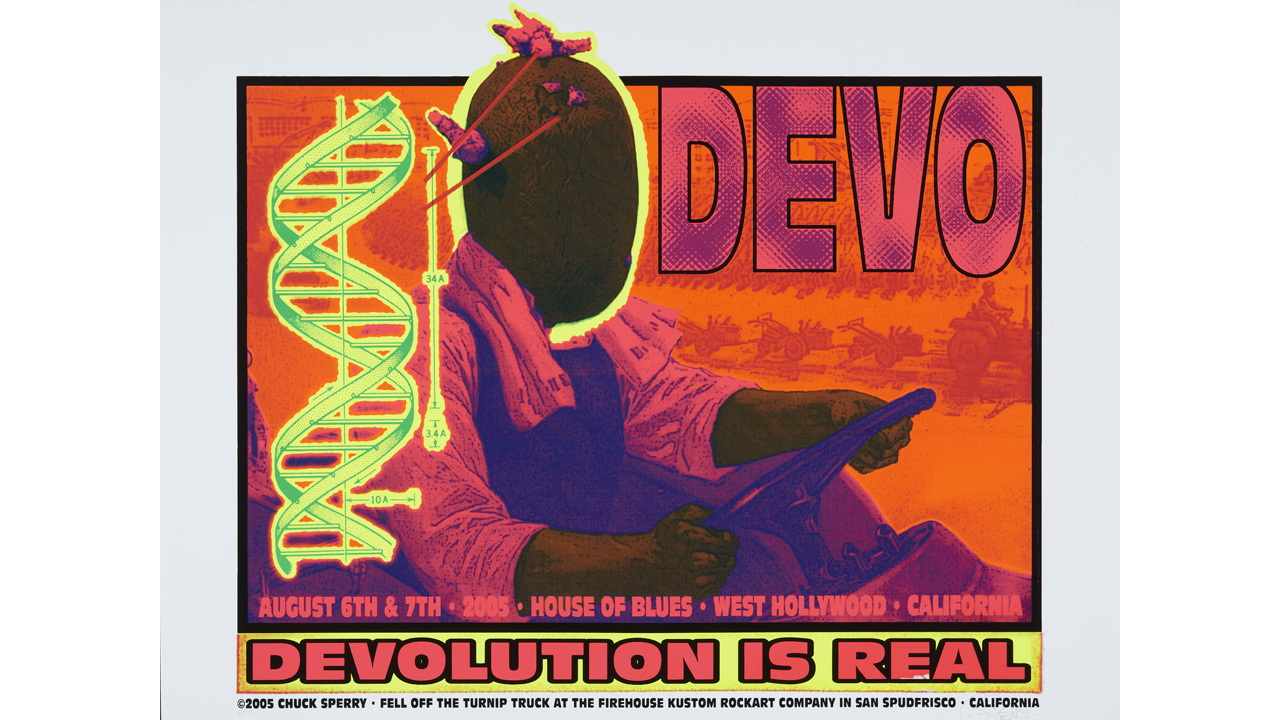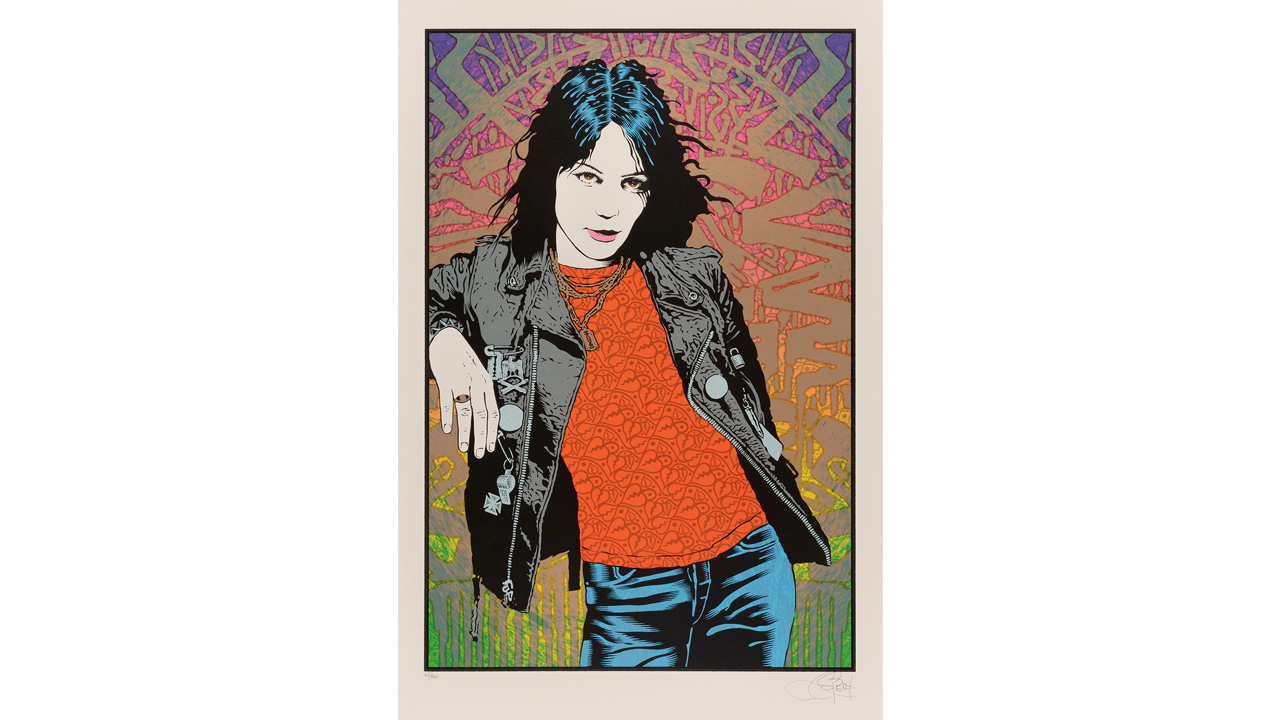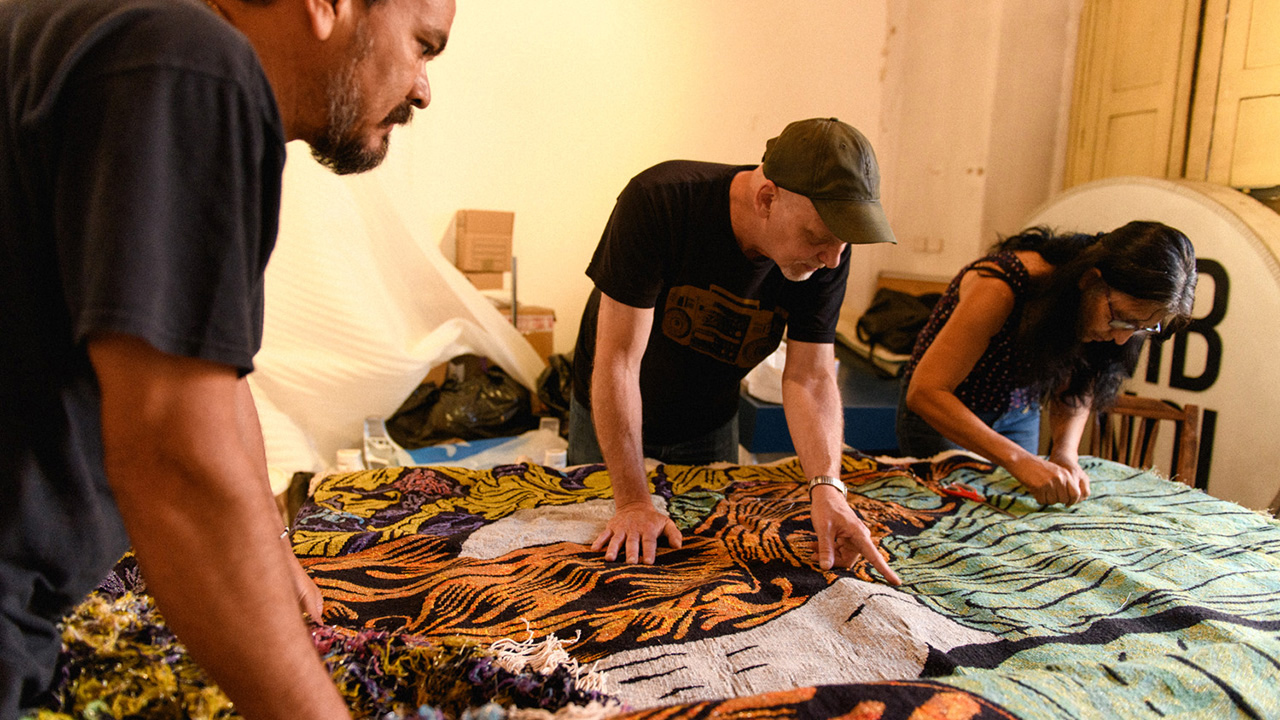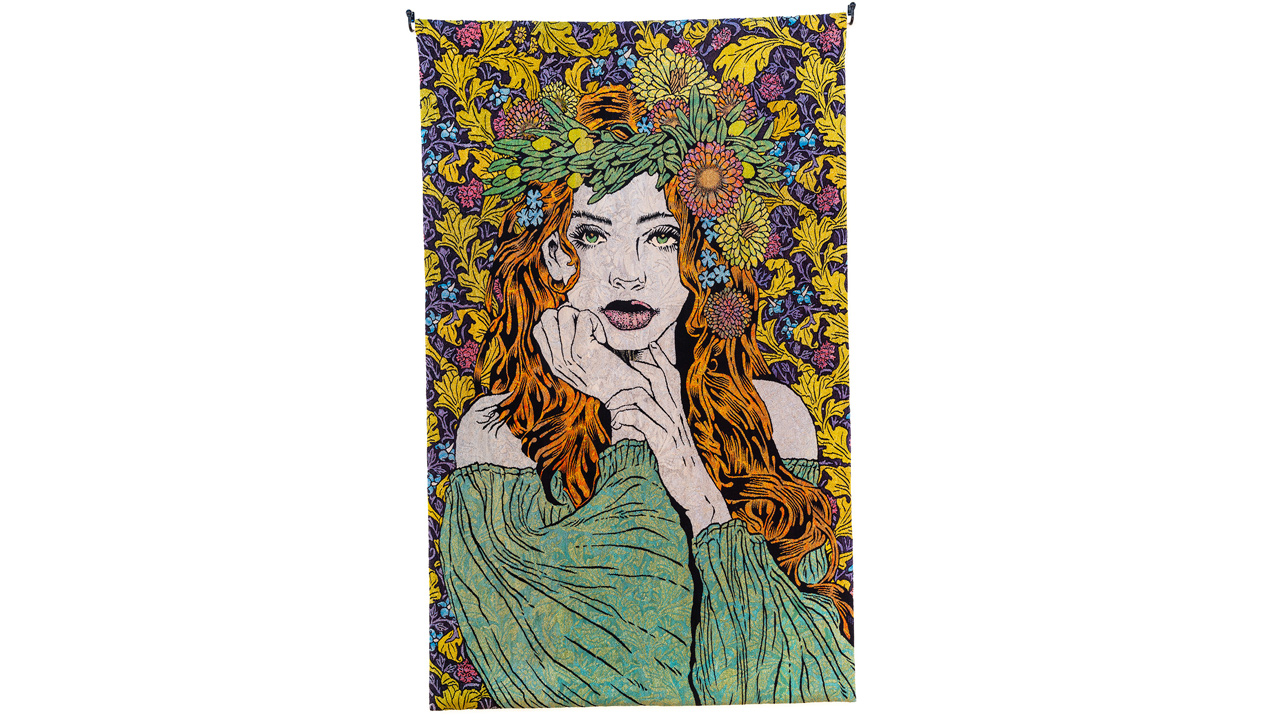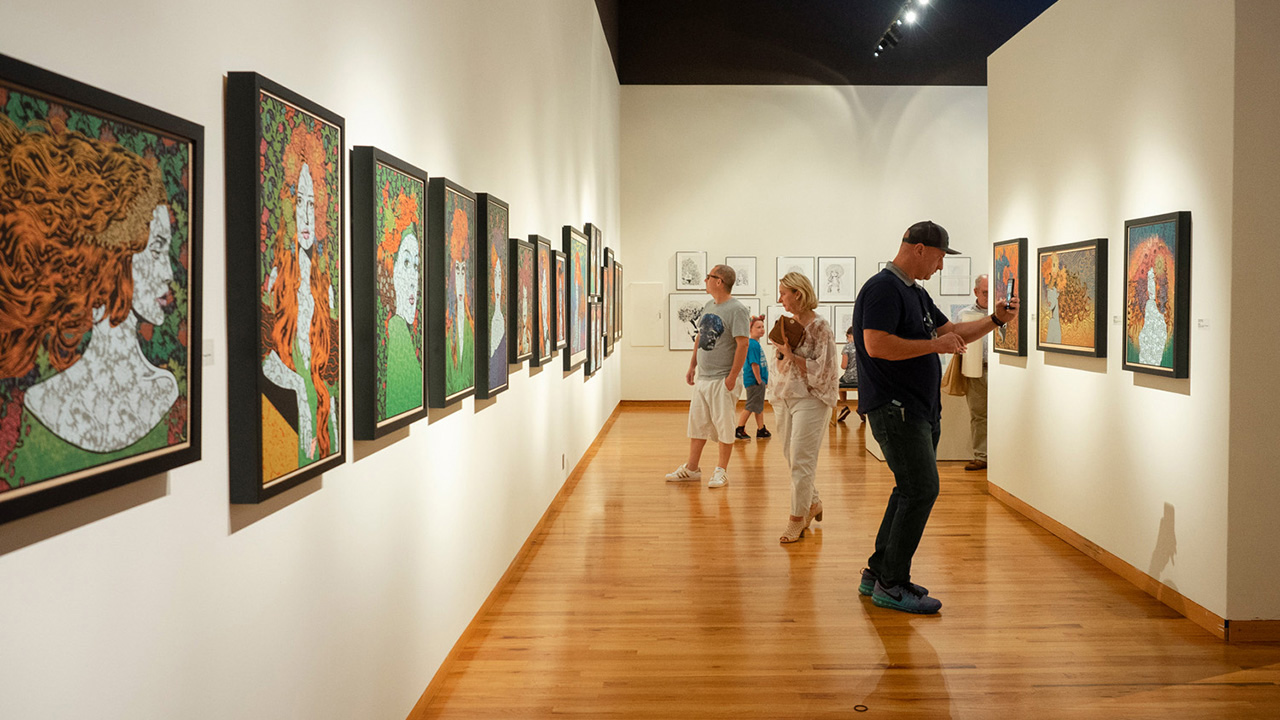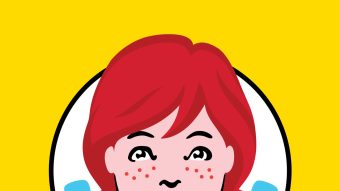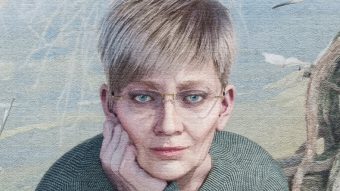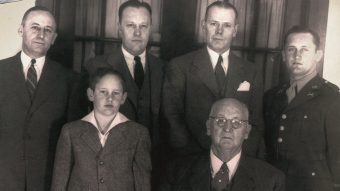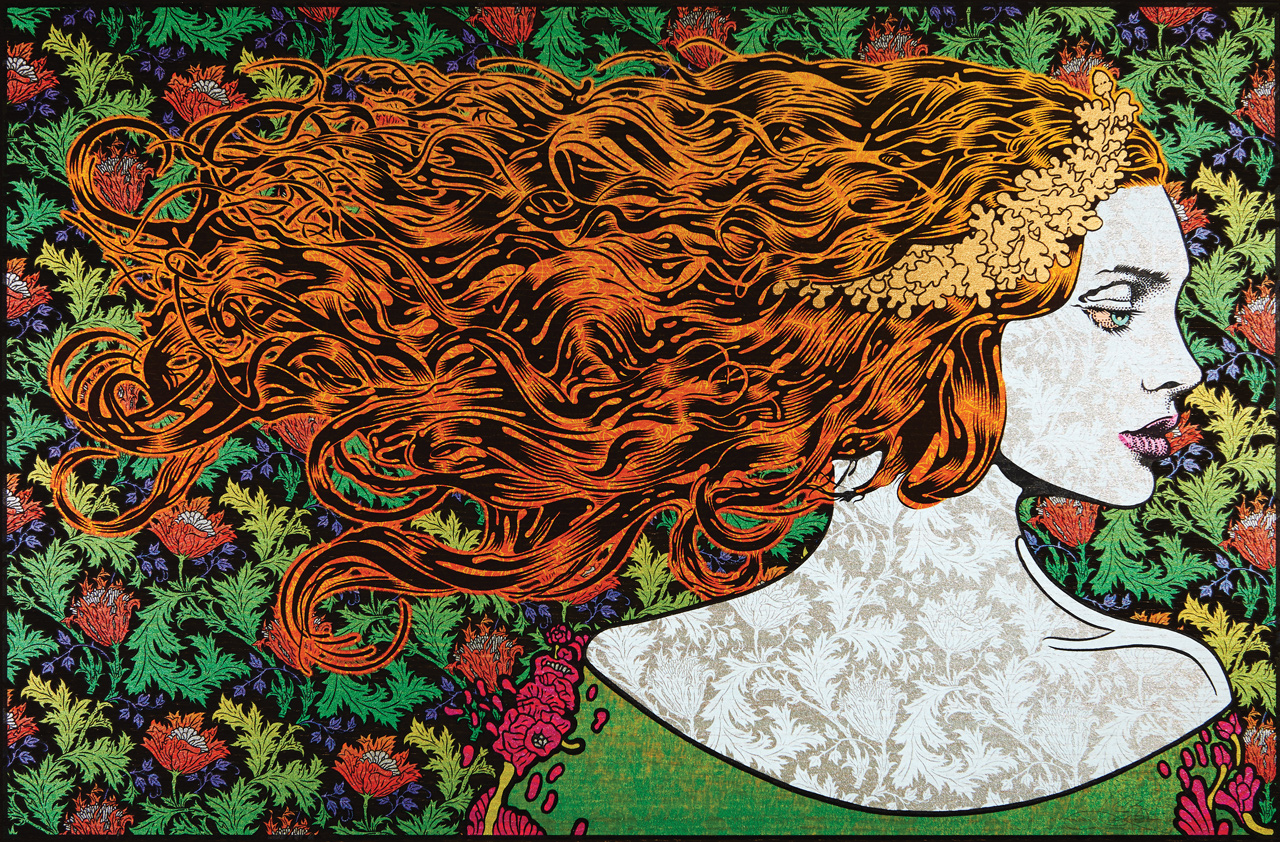
Published on Show Me Mizzou August 19, 2021
Story by Justin Heckert, BJ ’02
Jesse Hall is a great place to skateboard.
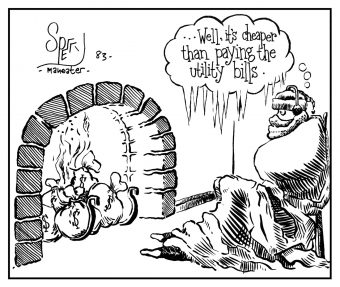
Chuck Sperry learned this one night when he was the only person there. He was inside the building when he got the idea, and not out on those long concrete paths around the Columns with a view of the dome. He felt inspired that evening. With Jesse’s vast and musty hallways to himself. The now-famous artist was the editorial cartoonist for The Maneater back then, in the early 1980s. He had long blond hair and smoked cigarettes on the stoop of that CoMo dive bar the Shack. He carried a banana board under one arm and was surprised at just how quiet its wheels were inside the most famous building on campus. The Jesse floors vibrating through the board as he sped, Sperry doing ollies past the empty rooms, the old wooden doors flying past him. He tells this story now like it was a secret he kept for almost 40 years. He describes this over the phone, giggling the whole time, shuffling art supplies in the background, reminding himself that he actually did it, probably (maybe?) something no one else on Earth has ever done.
“Basically, I had free rein at night,” Sperry says, excitedly. “I would skate around; it was such a great surface at Jesse. You could do skids and stuff. No one was there but me! I had my skateboard, and I was thinking, ‘This is going to be great.’ ”
Sperry, Journ ’84, is on the phone from his studio in the Warehouse district of Oakland, California, Hangar 18, an airplane-storage-size workspace where he screen prints lush concert posters by hand in a style immediately recognizable, a style now a part of American popular culture, even if his name isn’t a household word. Those intricate images layered in vibrant colors. The official posters for the likes of the Who and Eric Clapton and Bob Dylan and Dave Matthews and the Black Keys. Huge bands soliciting him to do a poster for them and giving him total artistic control.
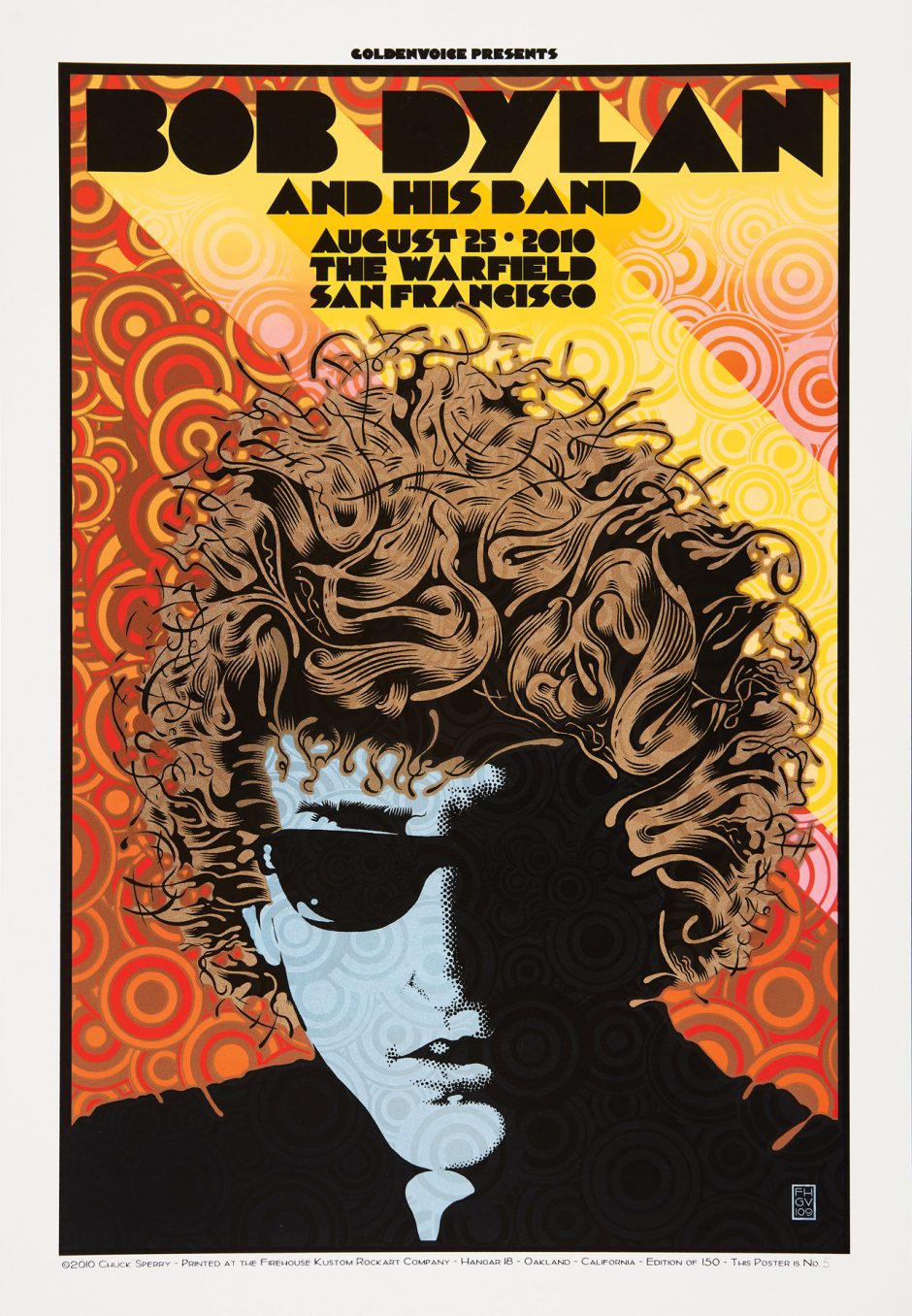
When he makes these posters and puts hundreds of them by the batch on his website, “It’s gotten so ridiculous that they sell in like 30 milliseconds or something,” he laughs. Sperry has fans — people who actually go to Oakland just to knock on the hangar’s door or catch him working. People who form a line the night before like it’s Black Friday outside Hangar 18 when Sperry gives a scheduled tour of his archive inside. And his work has been everywhere: in Italy, at Red Rocks, at the Fillmore, on permanent display at the Rock and Roll Hall of Fame. For years he made the band posters for the Virgin Megastore in New York City. He even has a print portrait of Sharon Stone from Casino somewhere on a wall at Martin Scorsese’s house.
“A concert poster itself is so extremely ephemeral. It took decades to view it as a piece of art and not an artifact,” says Josef Zimmerman, curator at the Fort Wayne Museum of Art, which is scheduled to host Sperry’s “Color X Color” career retrospective exhibit April 24 through July 25, 2022. “We’re looking it at as art because of him. From the screen printing aspects to the design aspects to his color palette, the dude is a master of his craft. The amount of time that he puts into this work to get such high detail out of those screens, without it being individually printed. That’s the stuff that blows my mind. People are still screen printing, but not on that level.”
Sperry studied art and journalism at Mizzou. Columbia is where he made his first concert poster — a Xerox for a local band performing at the Blue Note — not knowing it would become a lifelong means of expression. The Maneater is where he learned about deadlines, too, and where his professional career started, with a nod to the political. Where a kid from Ohio approached the editors as a freshman because he read an issue in the dining hall and saw the editorial cartoon and thought, “Eh, I can do better than this.” Columbia is where Sperry first learned the basics of screening at a local print shop. It’s where he met Frank Stack, an art professor and luminary cartoonist who ended up being a mentor while he was at Mizzou, the two bonding over burgers at the Heidelberg, an influence that would find his way into Sperry’s work the rest of his career.
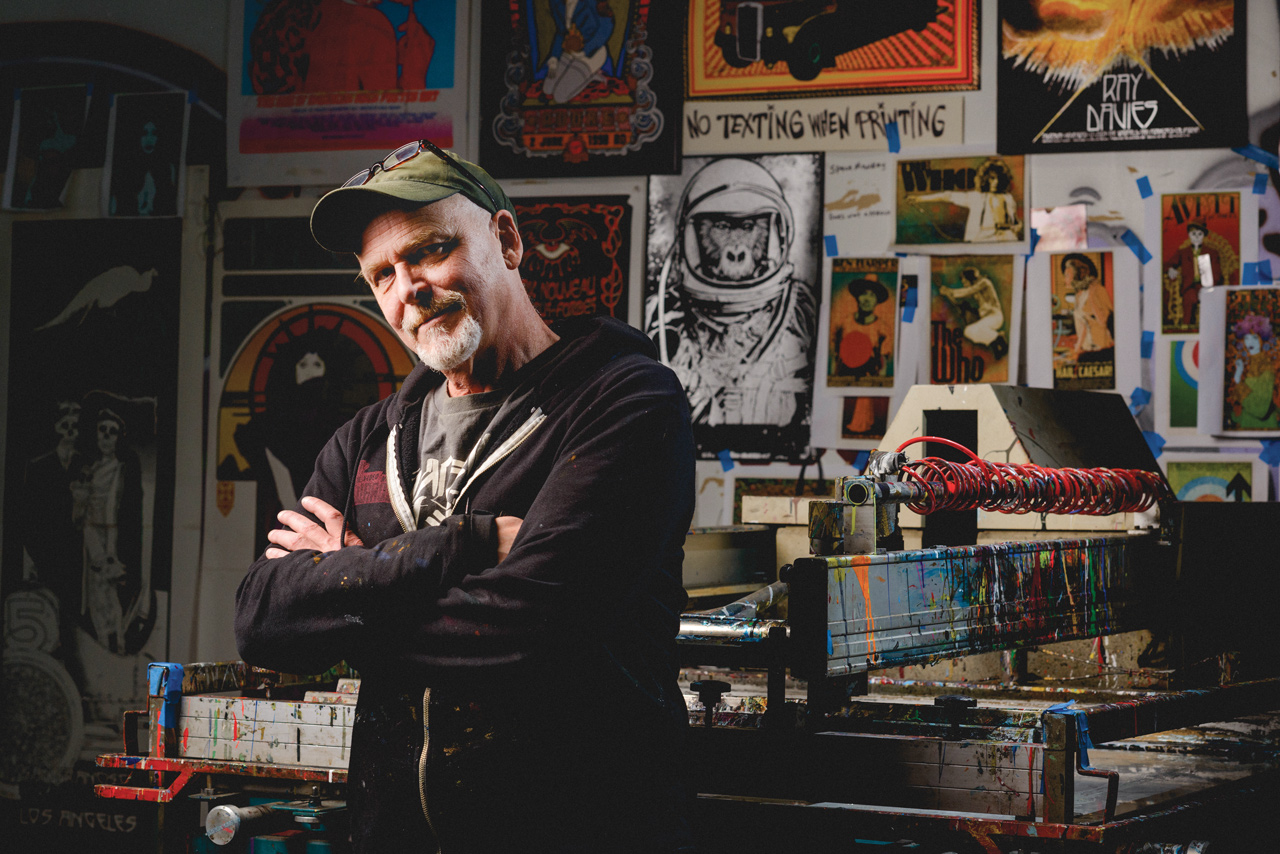
“I remember it was really easy to just knock on his door and spend an hour or more just, like, rapping out about stuff,” Sperry says. “He was just huge into the visual culture of America at large. We would have these discussions about 1930s movies, and he inspired me to aspire to be a cartoonist like Robert Crumb or Robert Williams. I kinda saw punk rock as like our version of the 1960s counterculture. I started doing band flyers and doing cartoons and comics.”
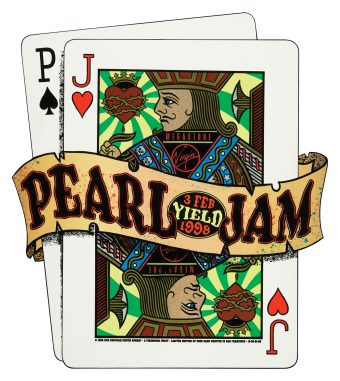
Sperry sat with a sketchbook on the third floor of Read Hall at The Maneater for four years, in the clatter of typewriter keys, student journalists yelling and throwing glue sticks back and forth in the paste-up room. The walls of the newspaper office layered in student graffiti from as far back as the 1940s. Sperry’s early drawings featured dudes with huge lambchop sideburns, nuclear missiles, Ronald Reagan, Gorbachev, a Cold War always on the brink of disaster. His cartoons usually ran with an editorial twice a week.
“There was craziness and late nights,” says Warren Strobel, BJ ’84, Sperry’s editor at the paper and now national security reporter for The Wall Street Journal. “Chuck would come in during the week to discuss what we were doing and what our editorials would be and then come back with a draft. That was one of my favorite parts of the week, working with Chuck — a total break from dealing with stories that were incomplete or needed to be sent back to writers. He was very sure of himself. He quickly would come up with concrete ideas about how to do an editorial cartoon that would fit the theme of the issue.”
Near the end of his time at Mizzou, Sperry knew he wanted to be an artist. He stuck around town for a year, making posters for local punk bands, crashing at a house he and his friends nicknamed the Bone House. “It was a two-story house with six punk rockers living in it. All of us were kind of semi-employed,” Sperry says. “We were making music or making art. That was a really cool scene.” Before he moved to New York’s East Village, Sperry did an illustration for the Columbia Tribune on a story about Sen. John Danforth; the writer was Major Garrett, BA, BJ ’84, now the chief Washington correspondent for CBS News. Sperry lived in New York City from 1985 to 1989 as an editor and aspiring illustrator for the underground-comix-inspired biannual magazine World War 3 Illustrated. But he didn’t find the start to a real career there. He made no money, basically squatted at a friend’s rent-free apartment and wondered whether art could be lucrative. So, he decided to move back to Columbia and roof houses for a while, making what seemed like a ton of money at $10 an hour. He got enough cash together to move to San Francisco.
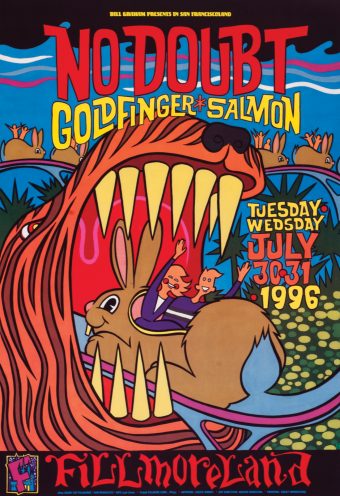
That was ground zero of the scene and the art that had inspired him as a student. He was hired at a comic-book store in Haight-Ashbury and began to meet other artists while inking his own stuff. A huge break came in 1994 when he was hired to make glossy band posters for the Fillmore Auditorium by Bill Graham Presents (in his portfolio were some Maneater cartoons). He was in his 30s, many of his friends already giving up on making art a career. His posters for the Fillmore were bright and loud with huge cartoonlike lettering, and often hilarious, to promote bands like Flogging Molly and No Doubt. “I was really impressed that he was such a great lettering artist as well as an illustrator,” says Arlene Owseichik, the art director at Bill Graham Presents who hired Sperry. “His work was always really clean and kind of simple, bold. We always appreciated posters that told a story. One of my favorite posters of all time was his No Doubt poster. Every time I look at that thing, it just makes me happy. It has the type integrated with the drawing, and the drawing is humorous, but yet it’s appropriate. No Doubt was from Anaheim; Disneyland is in Anaheim. It’s just happy and kind of irreverent. The people on the roller coaster are nuts.”
The job creating posters for the Fillmore eventually led to Sperry getting a gig to paint the walls of a local firehouse — an abandoned structure that became his first studio, where he was able to screen print some of the posters that cemented his career. Sperry was making posters with recurring characters in his work, these intricate screen-printed pictures of people with tails, skeletons, cherubic kids smoking cigarettes, giant squids and evil voodoo zombies. Bands took notice of these eye-catching pieces of art. In 2016, Sperry got commissioned to work on a poster for Black Sabbath — a dream for him.
“I would say that around 2008 he really began to develop some traction for his gig posters,” says Ken Harman, owner of the Spoke Art and Hashimoto Contemporary galleries in San Francisco and New York, respectively, both venues that showcase Sperry’s work. He calls it, “equal parts like turn-of-the-century art nouveau meets punk rock meets like classical like Greco-Roman antiquity. The smartest bands let him do whatever he wants. People come to shows just for his posters.” The setup at Hangar 18 is vast, and Sperry doesn’t just do singular gig posters there — though the quality and work is the same for one of Sperry’s posters and a work intended as a fine-art print. “I think to some degree he designs gig posters however he wants to design them,” Harman says. “But when he makes a fine-art print, his only considerations are what he’s interested in exploring, so he has more creative control and flexibility.”
Sperry’s studio has several exposure tables where he makes his screen prints. Each table’s vacuum seal, which is made from wetsuit material that Sperry must replace by hand regularly, holds a screen vertical against a large glass plate so that he can expose the image onto the silk screen with UV light. It bakes the image in seconds. He works inside near the tables like he’s doing an ancient ritual, the light created brighter than the sun. This art equipment has been customized over the years to Sperry’s specifications, including the washout booth and an old, ink-stained printing press he bought from artist Frank Kozik. His printing process is how he’s able to get so much texture on his prints. It also enables a color palette that is bright and vibrant to iridescent. The heavy fumes from the oil-based ink compel Sperry to wear a respirator mask, the smell of the room forcing anyone else out. Oil-based colors are brighter and more translucent than the water-based inks many artists use. He is one of the few artists still doing it all by hand at every step.
“Really, for 20 years, I’ve just considered that every time I’m making a gig poster, it should be the highest possible quality,” Sperry says. “Just because it’s a poster doesn’t mean it can’t be art. And, so, the craftsmanship that goes into both is the same.”At Mizzou, Sperry lived on the first floor of a house on Elm Street. The walls of his room were covered in posters of the Clash, U2, Elvis Costello, The Who, a vintage poster of Frank Zappa. He didn’t know what he wanted to do, exactly, back then. He kept a skateboard in his room. He found inspiration everywhere, like in Schurz Hall hanging out with his friends, like in the food at Ernie’s being a perfect cure for a hangover (he would make comics about this). At Memorial Union as he sat in the ticket booth and watched all the people pass. Early inspiration in the music of his friends’ bands and in the town itself. And skateboarding, of course, at night, in the dark at Jesse Hall.
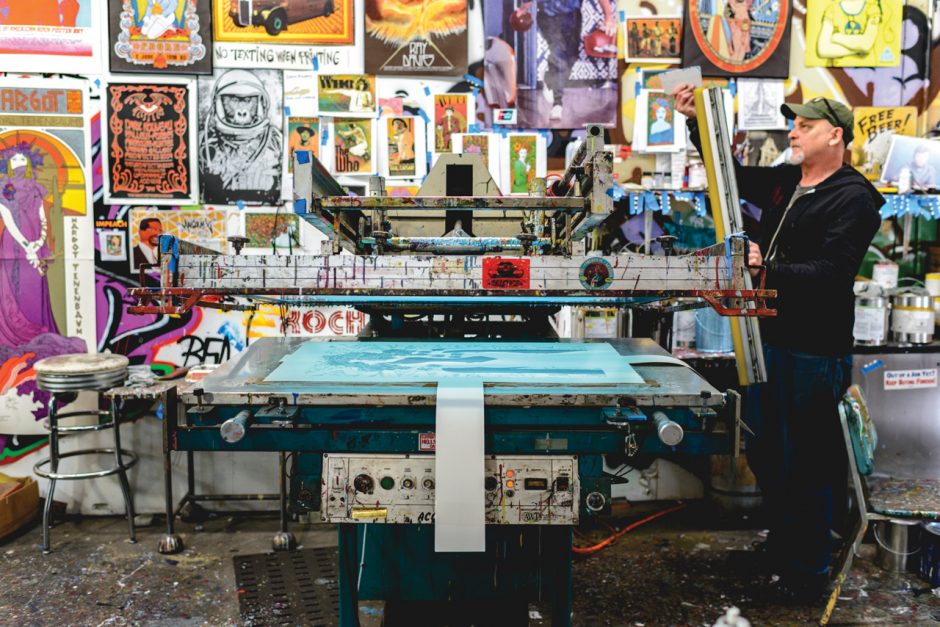
To read more articles like this, become a Mizzou Alumni Association member and receive MIZZOU magazine in your mailbox. Click here to join.

